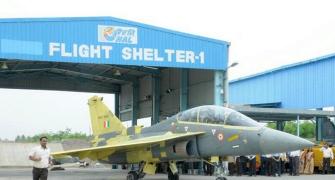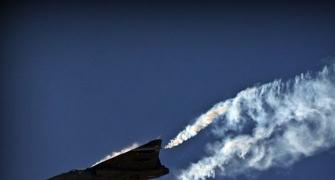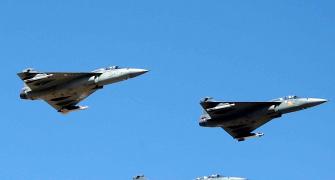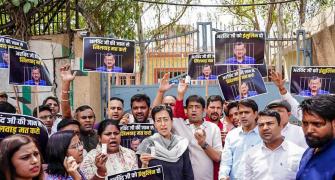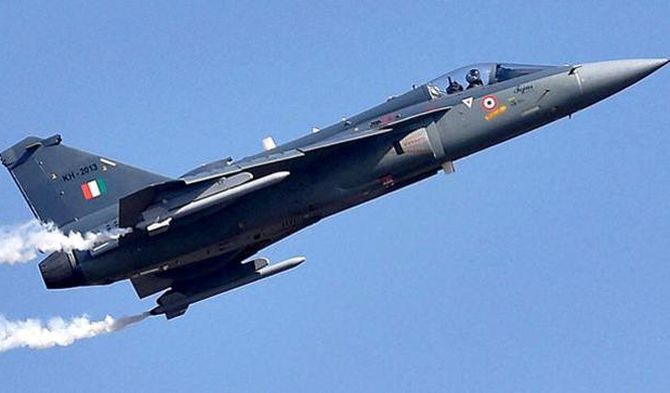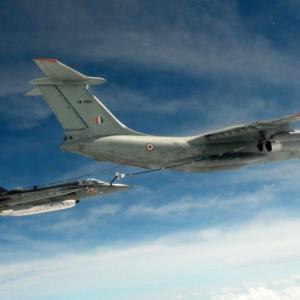'The air force has treated the Tejas like a step child.'
'The Tejas has grown in capability, but the IAF has preferred foreign fighters like the Rafale.'
Ajai Shukla reports.

For 10 months now, Hindustan Aeronautics Ltd's proposal to manufacture 83 Tejas Mark 1A fighters, which the ministry of defence green-lighted in December 2017, has been pending with the Indian Air Force.
With no clearance forthcoming from the IAF's 'technical evaluation committee' (TEC), the project remains in limbo.
HAL's commercial bid remains unopened and an actual production order, at a price to be fixed by a 'cost-negotiating committee', is nowhere in sight.
This Tejas Mark 1A order, worth Rs 50,000 crore (Rs 500 billion) in the estimation of Defence Minister Nirmala Sitharaman, constitutes half the orders worth Rs 100,000 crore (Rs 1 trillion) that she told Parliament had been given to HAL, and then later clarified were 'in the pipeline'.
The pipeline should have a clearly defined length. The Defence Procurement Procedure of 2016 (DPP-2016) requires the TEC to complete its evaluation in 10 weeks. It has already been with the IAF for 10 months.
Contacted for comment, the IAF has not responded.
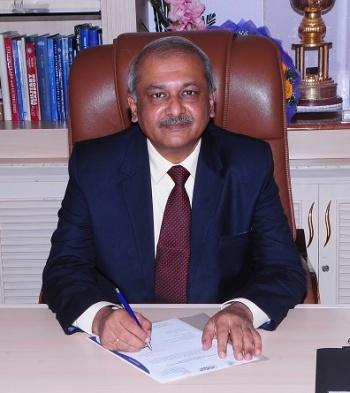
HAL Chairman R Madhavan says the order is vital for smooth production. This year, HAL's Tejas integration line will deliver eight fighters, and will also ramp up production to 16 fighters a year.
However, there are only 20 more Tejas Mark 1 fighters on order. That means, without the order for 83 Tejas Mark 1A aircraft, the line will grind to a halt in 2020.
For now, HAL's only hope is that prospective foreign customers, such as Malaysia, place orders for the Tejas, which would keep its production line going. The Royal Malaysian air force could buy up to 30 Tejas Mark 1 fighters.
"We cannot afford Tejas production coming to a stop. Stop-and-start production has financial costs, and disrupts the supply chain. And delay raises labour costs and foreign exchange appreciation," says Madhavan.
The IAF counters that HAL is still to deliver two orders it has received for 20 fighters each. But, in fact, the order is only for 32 fighters, not 40.
The remaining eight fighters are the twin-seat trainer variant, for which the IAF is still to issue the 'air staff requirements' (ASRs) -- or the specifications to which they must be built.
This delay is happening because, in 2016, the IAF suddenly demanded that its twin-seat trainers must also have mid-air-refuelling capability.
This capability had earlier been decided for only the single-seat fighter, but was not required in the twin-seat trainers.
The IAF's change of mind involves significant re-engineering, since the long, drooping nose of the twin-seater presents additional challenges.
HAL can start this development only when the IAF issues the ASRs for mid-air refuelling for the twin-seat variant. Thereafter, the development would take at least two years.
Only then can the twin-seat Tejas -- 8 trainers from the first order of 40 aircraft and 10 from the 83 Mark 1A order -- enter production.
Until then, only two Tejas trainers exist -- prototypes built years ago. With no twin-seat trainers being built, there are serious problems in training Tejas pilots.
Since the existing two twin-seaters are needed for the flight-test programme, rookie Tejas pilots must rely on mainly simulator training, rather than real flying.
In the Tejas assembly hangar, this correspondent saw two spanking new Tejas fighters ready for delivery. Another two were getting their final touches.
When those are delivered by March 31, HAL will have -- for the first time -- achieved the production milestone of 8 fighters per year.
The IAF charges HAL with having taken too long to reach this level of production. But the HAL chief ascribes that to the IAF constantly shifting goalposts.
"Much of the delay is due to changing Tejas specifications. Tejas production was cleared in 2013. But, from that time till today, there have been over 300 changes to the fighter. We need to freeze a single standard for the fighter," points out Madhavan.
Endemic delays in the Tejas programme -- whether due to developmental delay by the Defence R&D Organisation, production delay by HAL or the absence of oversight and ownership by the IAF -- have had severe financial repercussions.
In 2006, the contract for the first 20 Tejas Mark 1 was concluded at a price of Rs 106 crore (Rs 1.06 billion) per fighter. In 2015, when production finally got underway, HAL submitted a request asking for it to be increased to Rs 194 crore (Rs 1.94 billion).
The second batch of 20 fighters will likely top Rs 200 crore (Rs 2 billion) apiece.
And the 83 Tejas Mark 1A, with significant (and expensive) capability enhancements demanded by the IAF – including advanced radar, electronic warfare systems and better maintainability – will likely cost over Rs 400 crore (Rs 4 billion) per fighter.
"Ultimately, the blame lies with the air force which has treated the Tejas project like a step child. The Tejas has grown in capability, but the IAF has preferred relying on foreign fighters like the Rafale," says Bharat Karnad of the Centre for Policy Research.
"Now," Karnad adds, "if orders for the Tejas Mark 1A are not placed early, its cost will rise, giving the IAF yet another reason to oppose it."


